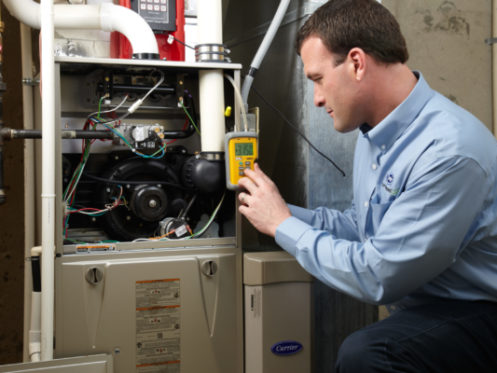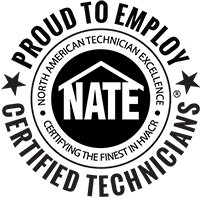Cleaning your furnace burner intimidates even experienced homeowners, but it’s not as difficult as it sounds. Keeping your furnace clean is crucial to having an efficient HVAC system in your home. It can also save you from spending the winter months feeling chilly.
Most modern furnaces do not require too much work to take apart. It is always best to allow a professional technician to do the work, however. Older furnaces can be pretty finicky. Luckily, most furnace tune-ups come with professional cleaning.
Technicians cleaning a furnace will need a few key items to get started.
- Steel Wool
- Wire Brush
- Screwdriver
- Socket Wrench
- Air Compressor
During this process, professional technicians typically use a brass wire brush and very fine steel wool. Although the difference between older and newer models can be vast, the general steps for cleaning furnace burners remain the same.
1. Power Down the Furnace
One of the most critical safety steps is to power down the furnace properly before cleaning its burners. To do this, the technician must flip the electrical power off by going to the main panel and turning off the breaker associated with the furnace. The technician will also need to find the main gas supply valve that controls the furnace’s gas supply and turn it off. While these are simple procedures, they are essential to safe furnace cleaning. Failing to do these steps can be hazardous.
2. Record Placement of Burner Parts
Most technicians will take detailed pictures of your burner’s setup before cleaning your furnace. These pictures will be a reference guide to putting your furnace back together quickly and efficiently. Because there are many different furnace models, these pictures help them provide fast and specialized service.
3. Gently Take Off the Burner Retaining Plate
The burner retaining plate is part of the combustion chamber of your furnace. The professional must gently remove it with either a screwdriver or a socket wrench. Depending on your model, there will be several screws holding the burner retaining plate in place. If your burner has not been cleaned in a long time, these screws may be rusty and difficult to remove.
4. Remove All of the Burners From the Unit
Before cleaning the burners, the technician must remove every single one of them from the unit. Burners predominantly come in cylindrical shapes, which makes them easy to grip. Most technicians begin on the side next to the gas valve, grab the closest burner, carefully detach it from the combustion chamber, and remove it from the unit. These burners can be very delicate, especially the burners close to the hot surface ignitor.
5. Clean All Burners Individually
A worker will carefully clean the debris accumulating on the burner’s end with a brass wire brush. Most debris will be on the end that is closest to the combustion chamber. Then, the professional will blow compressed air through the burner to eliminate any carbon that has built up. Technicians will pay particular attention to the fins on each burner’s side. These fins allow the burners to ignite. Cleaning them is essential to a working furnace.
6. Polish the Flame Sensor
Flame sensors live right behind the final burner. A flame sensor is a tiny rod that gets drenched in carbon throughout your furnace’s lifetime. The carbon will accumulate on the flame sensor, so it must be cleaned with the burners. A technician must detach it from the wire and the screw holding it to the unit. Then, the professional will clean it with fine steel wool and reinstall it into the unit.
7. Reinstall Burners and the Retaining Plate
One of the final steps is carefully reinstalling all the individual burners and the retaining plate. A worker will start reinstalling the burner farthest from the gas valve and gently place them back horizontally. Workers need to be careful during this step. These parts can break another part of the furnace if forced into position. After all the burners are back in place, the retaining plate gets put back to cover the burners.
8. Test the Furnace to Ensure Everything Works
To test the furnace, the technician will turn on the gas and electric power. A simple test to ensure the quality of your furnace emissions is turning up the furnace thermostat and observing the flame color. Yellow or orange streaks that will not disappear are signs that the cleaning did not go well. If you instead see steady blue flames, your furnace is operating well.
For most homeowners, the best decision is to call a professional technician. Not only is this less of a safety risk, but it is also much less stressful for people with old and complicated furnaces. Our company provides professional and dedicated furnace maintenance. We provide the best burner inspection and cleaning to residents in Mishawaka, IN and throughout the wider Northern Indiana and Southern Michigan areas. We also provide excellent cooling system services. At Tyler’s Heating & Cooling, we have an enthusiastic and knowledgeable customer service team that can answer any questions you have. Please contact Tyler’s Heating & Cooling today to learn more.

